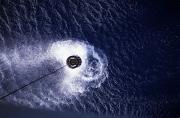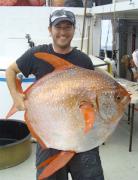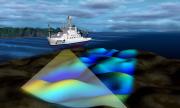Radio Program
Our regular Science and the SeaTM radio program presents marine science topics in an engaging two-minute story format. Our script writers gather ideas for the radio program from the University of Texas Marine Science Institute's researchers and from our very popular college class, Introduction to Oceanography, which we teach to hundreds of non-science majors at The University of Texas at Austin every year. Our radio programs are distributed at to commercial and public radio stations across the country.
To a whale, sonar can be the equivalent of a heavy metal concert. The sonar can overpower other sounds, so the whale can’t hear its companions or prey. If the sonar is especially close, it can cause hearing loss. And not to carry the metaphor too far, but the sound may lead to confusion that causes the whales to flee in terror -- and perhaps even strand themselves on the beach.
Sonar sends out pulses of sound, then records the “echo” from submarines, sunken ships, or even the ocean floor. And the sound can travel across hundreds of miles.
Salt marshes cover millions of acres of American coastline, particularly along the Gulf of Mexico. Their shallow, grass-filled waters provide habitat for fish and shellfish, birds, and other critters. They also filter nutrients from runoff, which can reduce the “dead zones” that sometimes form offshore. And, they help limit coastal flooding during tropical storms.
Athletes are always looking for that extra edge -- a way to beat the other guy by running a little faster or hitting a little harder. A fish that looks like a silver plate standing on its rim has found its own edge: it warms its body to well above the surrounding water temperature. That should allow it to swim faster and longer, improve its vision, and keep its organs in good shape as it cruises through cool, dark waters.
The geology of the ocean floor is just as varied and amazing as that of dry land. Mountain ranges stretch across thousands of miles, trenches plunge miles deep, and cracks in the crust look like the furrows of a plowed field.
Yet not only is much of that landscape unseen, it’s unknown. Only a small fraction of the ocean floor has been mapped in as much detail as the land. And large areas have barely been peeked at.
Dolphins and porpoises are among the smartest and most beautiful creatures on the planet. And they’re also among the most popular. Even so, most of us can’t tell dolphins and porpoises apart. Yet there are several key differences, in both appearance and behavior.
Dolphins and porpoises are cetaceans -- a group of animals that also includes whales. There are 32 species of marine dolphins, but only a half-dozen species of porpoises. All of them are warm-blooded mammals that come to the surface to breathe air.
Life in the deep ocean could be headed for deep trouble. The food supply could shrink dramatically, starving many of the organisms that live on the ocean floor.
Living in the deep ocean is tough already. It’s cold and dark there, with far less food than at shallower depths. But our changing climate could make things even more difficult.
A recent study looked at various models of how the atmosphere and oceans could change by the end of the century. The study team then projected what those changes could mean for life in the deep ocean -- anything below about 650 feet.
The pigfish isn’t high on anyone’s list of good eating. Even so, it’s a popular purchase along the Atlantic and Gulf coasts. That’s because the pigfish makes great bait for catching spotted sea trout and other sport fish. It’s available for only a few months of the year, though, and its popularity as a bait fish could lead to a decline in its numbers. So researchers are testing ways to grow the fish in tanks.
It may never serve as the mascot for a football team, but the longhorn boxfish still grabs your attention, because two pairs of horns extend from its body. One pair extends from the top of its head, although the horns go forward instead of sideways like those of the well-known cattle. And the other extends backwards from the bottom of its box-like body.
But there are more intriguing things about the longhorn boxfish than its horns: the way it feeds, its tough skin, and the deadly toxin it produces to ward off predators.
The crust at the bottom of the oceans is dense, heavy, and tough. Even so, it disappears in a hurry -- it’s pulled into the layer below the crust, where it melts and vanishes.
If you build it, they will come. That’s been the case with an oyster reef along the Texas coast. The once-thriving reef had died out, but a recent restoration project brought it back to life. And lots of oysters and other marine creatures are now calling it home.
Half Moon Reef is in Matagorda Bay, about halfway between Galveston and Corpus Christi. In the early 1900s, it covered hundreds of acres. As the 20th century progressed, though, the reef was decimated by dredging, oyster harvesting, and changes in the water flow into the bay. Very little of the original reef was left.












